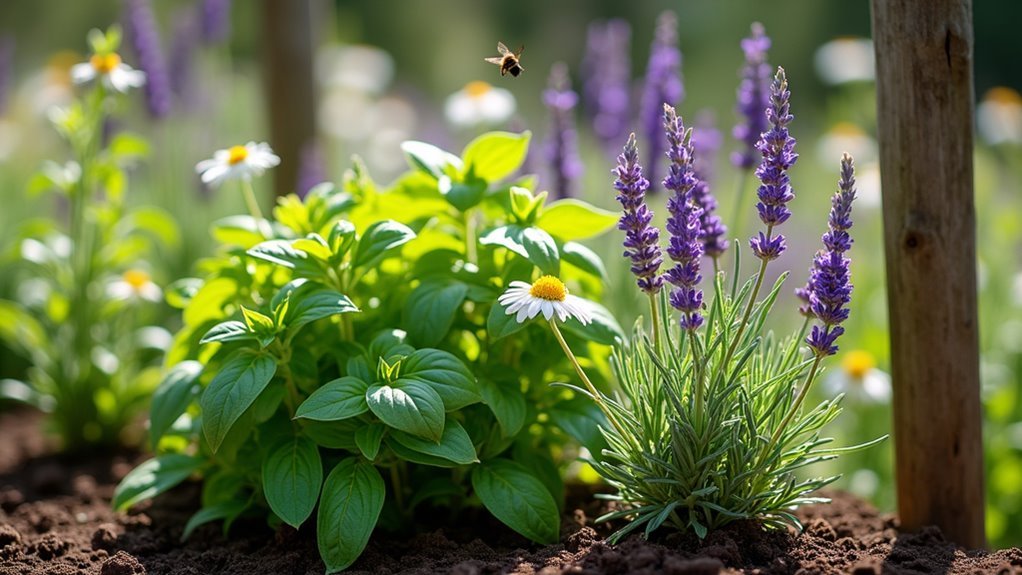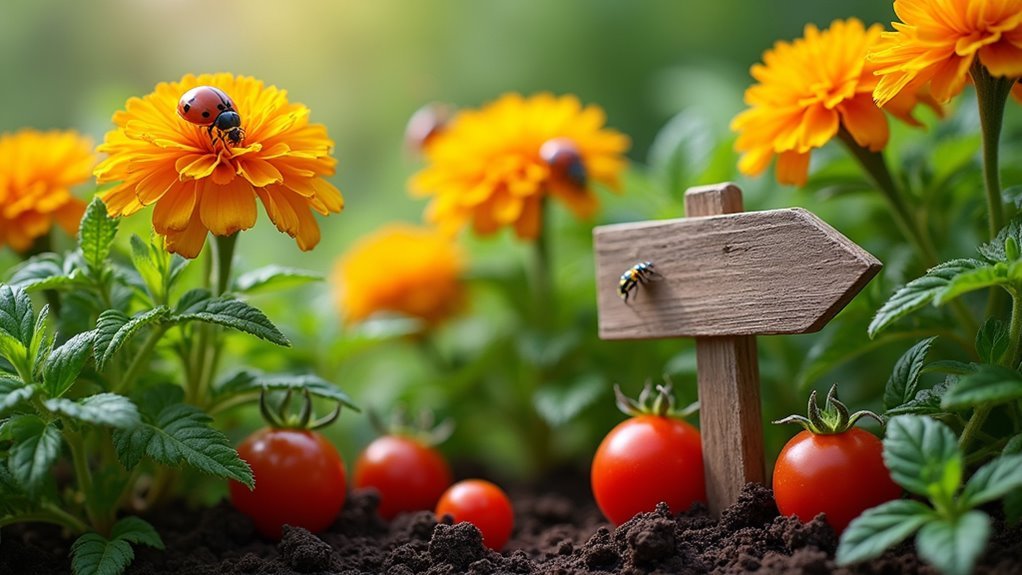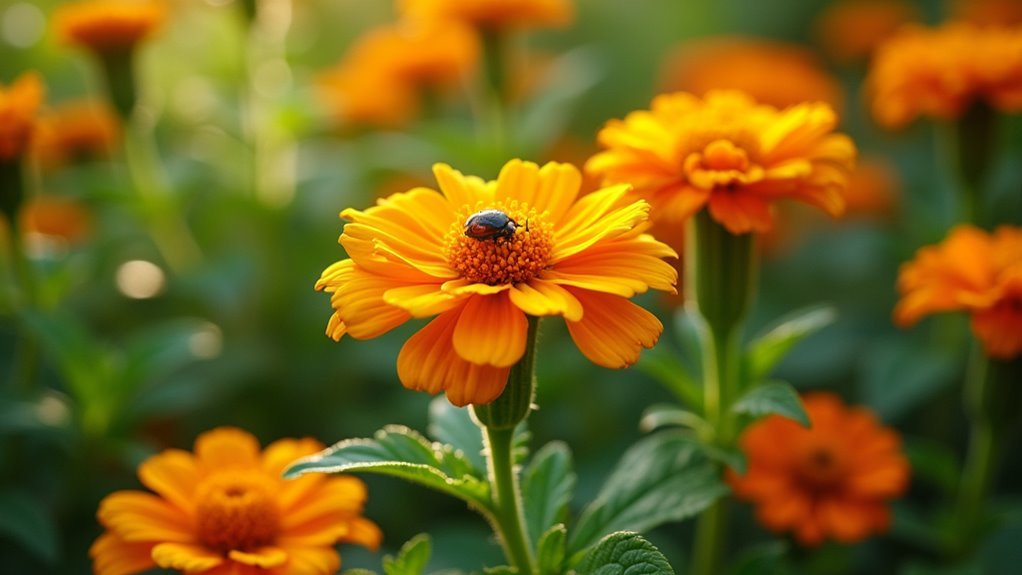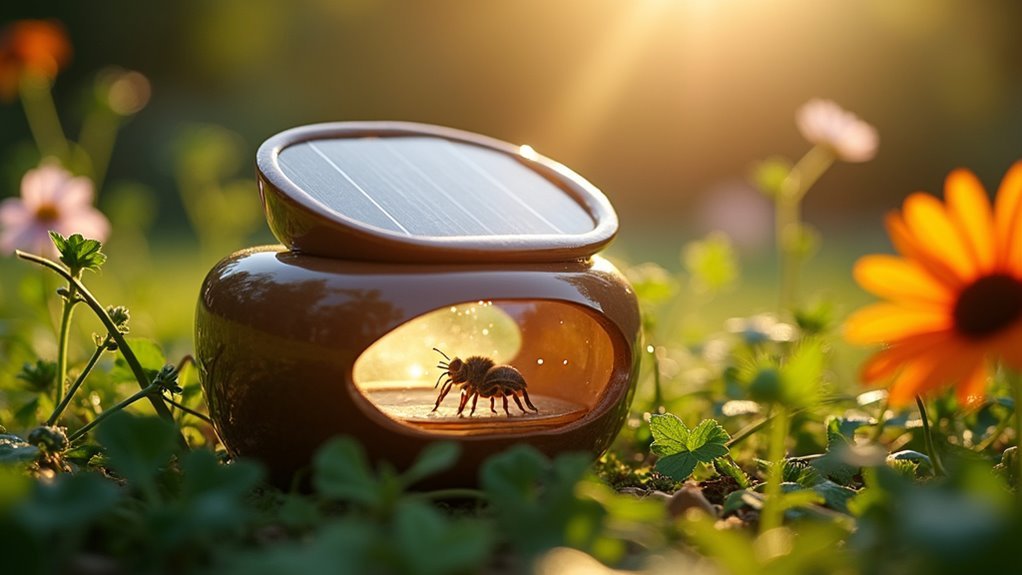You can dramatically reduce garden pests by planting aromatic herbs like basil and mint that confuse insects with strong essential oils. Use trap crops such as nasturtiums to lure aphids away from vegetables, while strategic allium placement creates sulfur-based protective barriers. Maximize plant diversity to disrupt pest hunting patterns and attract beneficial insects with flowering companions like marigolds. These proven combinations can reduce pest populations by up to 50%, and specific techniques will transform your garden’s natural defenses.
Plant Aromatic Herbs as Natural Pest Deterrents

When you’re battling garden pests without resorting to harsh chemicals, aromatic herbs become your most powerful allies. Planting herbs like basil, lavender, and mint creates natural pest deterrents that repel pests through their strong essential oils. These fragrant plants confuse flies, mosquitoes, and aphids while disrupting their ability to locate host plants.
Rosemary and thyme work particularly well in organic gardening strategies, as their oils interfere with pest detection systems. Meanwhile, chives and garlic not only repel destructive nematodes and beetles but also attract beneficial bugs when flowering.
This dual-action approach helps reduce pest populations naturally while supporting beneficial insects that prey on harmful species, creating a balanced garden ecosystem without chemical intervention.
Use Trap Crops to Lure Pests Away From Main Plants
While aromatic herbs create protective barriers around your garden, trap crops take a different approach by deliberately attracting pests to specific sacrificial plants.
You’ll strategically place these decoy plants near your main plants to intercept harmful insects before they reach valuable vegetables.
Nasturtiums excel at protecting vegetables like cabbage and kale by luring aphids and cabbage moths.
Plant upland cress as a distraction for cabbage butterflies, while sunflowers draw stink bugs away from vulnerable crops.
These trap crops simplify pest management by concentrating insects in controlled areas.
Mustard and marigolds offer dual benefits—they repel pests like harlequin bugs and nematodes while simultaneously attracting beneficial insects.
Mustard and marigolds work double duty, repelling harmful pests while drawing in garden-friendly beneficial insects for natural protection.
This strategic companion planting creates natural pest control systems that protect your harvest without harmful chemicals.
Create Beneficial Insect Habitats With Flowering Companions

Beyond luring pests away from your crops, flowering companions transform your garden into a thriving ecosystem that actively recruits nature’s pest controllers.
You’ll attract beneficial insects like hoverflies and lacewings by planting cosmos and sweet alyssum, which naturally reduce pest populations. Marigolds serve dual purposes—they repel harmful insects while creating habitats for ladybugs and other predatory species.
Diverse flowers confuse pests and disrupt their breeding cycles, making organic pest control more effective.
Don’t overlook bolting vegetables; let your broccoli and kale flower to support pollinators.
Strategic placement of herbs like dill and fennel amplifies these benefits, as they attract both pollinators and natural pest controllers, creating a balanced garden ecosystem that works for you.
Maximize Plant Diversity to Confuse and Reduce Pest Populations
You can dramatically reduce pest problems by strategically increasing the variety of plants in your garden to create a confusing landscape that disrupts their hunting patterns.
Mix different crop types throughout your planting beds and surround them with aromatic herbs that’ll mask the scents pests use to locate their target plants.
This diverse ecosystem won’t just confuse harmful insects—it’ll also provide the flowering habitats that beneficial predators need to thrive and keep pest populations under control.
Create Confusing Scent Barriers
When pests search for their favorite host plants, they rely heavily on familiar scents to guide them through your garden. You can disrupt this navigation system by strategically placing fragrant herbs like basil, mint, and lavender throughout your beds. These aromatic plants create confusing scent barriers that mask vulnerable crops, making them harder for pests to detect.
Companion planting with diverse combinations of flowers and vegetables adds multiple layers of competing aromas. This complex scent environment attracts beneficial insects while deterring harmful ones. The natural interactions between different plants create an effective pest control system that confuses pests and promotes healthier garden ecosystems.
| Fragrant Barrier Plants | Target Pests Deterred | Companion Vegetables |
|---|---|---|
| Basil | Aphids, Spider Mites | Tomatoes, Peppers |
| Mint | Ants, Rodents | Cabbage, Broccoli |
| Lavender | Moths, Fleas | Carrots, Onions |
| Rosemary | Cabbage Moths | Beans, Carrots |
| Thyme | Whiteflies | Eggplant, Tomatoes |
Interplant Multiple Crop Types
Mixing multiple crop types throughout your garden creates a natural defense system that overwhelms pests with complexity.
Interplanting vegetables, herbs, and flowering plants disrupts pest feeding patterns by making host plants harder to locate. You’ll attract beneficial insects like ladybugs and lacewings through diverse plant arrangements, establishing effective natural control mechanisms.
When you incorporate aromatic herbs such as basil and mint alongside your vegetables, you’re masking scents that typically draw pests to their targets. This strategic mixing confuses insects and reduces their ability to establish damaging populations.
Polyculture systems prove remarkably effective—research shows they can reduce pest populations by up to 50% compared to single-crop growing methods.
You’re fundamentally creating an ecosystem where predator-prey relationships naturally regulate harmful insects while protecting your harvest.
Add Beneficial Insect Habitats
Dozens of flowering species strategically placed throughout your garden transform it into a sanctuary for beneficial insects that actively hunt down harmful pests.
Companion planting with cosmos and alyssum creates diverse habitats that attract beneficial insects like bumble bees and syrphid flies for natural pest management. You’ll confuse harmful pests by disrupting their scent detection while flowering plants provide nectar sources for predatory insects.
Nasturtiums and marigolds work as an effective trap crop, luring pests away from valuable vegetables while housing beneficial predators.
This companion planting strategy establishes a balanced ecosystem where pest control happens naturally. By maximizing plant diversity, you’re creating multiple microhabitats that support various beneficial insects throughout growing seasons, reducing your reliance on chemical interventions while maintaining healthier crops.
Strategic Placement of Alliums for Sulfur-Based Pest Repulsion
Although many gardeners overlook the power of strategic plant placement, positioning alliums throughout your garden creates a natural fortress against common pests. These sulfur-rich plants, including garlic, onions, and chives, release compounds that repels aphids, beetles, and slugs effectively.
Strategic allium placement transforms your garden into a pest-resistant sanctuary using nature’s own sulfur-powered defense system.
Place them around vulnerable brassicas like cabbage and broccoli to form protective borders. This organic companion planting method eliminates the need for chemical pesticides while enhancing garden biodiversity.
You’ll maximize benefits by interplanting alliums strategically rather than clustering them in one area. Space garlic cloves between tomato rows, plant chives along garden edges, and scatter onions throughout vegetable beds.
When alliums flower, they’ll attract beneficial pollinators while continuing to deter harmful insects, creating a balanced ecosystem that supports both pest control and soil health naturally.
Deploy Marigolds and Nasturtiums as Multi-Purpose Pest Fighters

Powerhouse flowers like marigolds and nasturtiums transform your garden into a pest-fighting fortress while adding brilliant splashes of color to vegetable beds.
Marigolds excel at companion planting by releasing compounds that repel nematodes and discourage aphids from attacking nearby crops. Their strong scent disrupts pest navigation, making it harder for harmful insects to locate host plants.
Nasturtiums work as living decoys, attracting aphids and cabbage moths away from your prized vegetables. This strategic pest control approach protects your harvest while concentrating damage on sacrificial plants.
When you combine these flowering allies, they’ll attract beneficial insects like ladybugs that devour garden pests. This dual-purpose pest repellent strategy delivers effective organic protection while creating stunning visual appeal throughout your growing space.
Test Specific Plant Combinations for Your Garden’s Problem Pests
You’ll need to identify which specific pests are causing the most damage in your garden before selecting companion plants that target those exact problems.
Start by testing proven combinations like thyme with cabbage for cabbage worms, or basil near tomatoes to repel hornworms, then carefully track how well each pairing performs.
Monitor your results throughout the growing season and adjust your plant combinations based on what’s actually working in your unique garden conditions.
Identify Garden Pest Issues
Why do some gardeners struggle with persistent pest problems while others seem to have naturally balanced ecosystems? The answer lies in understanding your specific garden pest issues before implementing companion planting for pest management strategies.
Start by identifying which pest insects are actually damaging your crops. Look for telltale signs like chewed leaves, wilting plants, or visible insects. This detective work determines which beneficial insects you need to attract and which companion plants will effectively control pests in your garden.
| Pest Problem | Companion Plant Solution |
|---|---|
| Cabbage worms on brassicas | Thyme plantings nearby |
| Squash bugs on zucchini | Marigolds near affected crops |
| Tomato hornworms | Basil around tomato plants |
| Armyworms on vegetables | Strategic thyme placement |
| General garden pests | Mixed companion plantings |
Once you’ve identified your specific challenges, you can select companions that repel problem insects while supporting your garden’s natural balance.
Trial Proven Plant Pairings
Three decades of gardening research have identified specific plant combinations that consistently outperform single-variety plantings against targeted pests.
You’ll achieve superior natural pest control by strategically selecting companion plants that work synergistically. Thyme planted near brassicas effectively repels cabbage worms and loopers, while marigolds interplanted with zucchini dramatically reduce squash bugs damage.
For tomatoes, combine basil and thyme to deter yellow striped armyworms and hornworms naturally.
Test nasturtiums with radishes to create trap crops that repels aphids from your main harvest. Sweet alyssum serves dual purposes in these plant pairings, attracting beneficial insects like hoverflies that eliminate pest caterpillars.
These beneficial insects provide ongoing protection while reducing your reliance on chemical interventions. Start with one proven combination and expand your companion planting system gradually.
Monitor Effectiveness Results
How can you determine whether your companion planting combinations are actually working? Start monitoring your pest populations weekly after establishing your plant combinations.
Document specific pest counts on vulnerable crops before and after implementing strategic placement of companion plants. You’ll need to assess damage levels, noting whether cabbage worms decrease around thyme plantings or if squash bugs diminish near marigolds.
Track beneficial insects too—they’re often attracted by companion plants and provide additional pest control. Take photos and maintain detailed records of plant health changes.
If you’re not seeing effectiveness improvements after 4-6 weeks, adjust your companion planting strategy. Remember that monitoring helps you identify which combinations work best in your unique garden conditions.
Frequently Asked Questions
What Companion Plants Keep Pests Away?
You’ll find alliums like garlic and onions repel aphids with sulfur compounds. Plant marigolds to deter nematodes, nasturtiums as aphid traps, aromatic herbs like basil for mosquitoes, and sweet alyssum to attract beneficial predator insects.
How Do Organic Farmers Keep Pests Away?
You’ll use companion planting with marigolds and nasturtiums as trap crops, employ physical barriers like row covers, maintain diverse plantings to confuse pests, and build healthy soil through composting for stronger plants.
What Plant Works as a Natural Pest Control?
You’ll find marigolds work exceptionally well as natural pest control. They repel harmful nematodes while attracting beneficial insects like ladybugs that eat garden pests, creating a balanced ecosystem that protects your plants naturally.
How Do You Get Rid of Bugs Without Harming Plants?
You can remove bugs manually, use floating row covers as physical barriers, spray homemade garlic or lavender repellents, and plant pest-repelling herbs like basil nearby without damaging your plants.
In Summary
You’ve got powerful organic tools at your fingertips with these companion planting strategies. Start small by testing one or two combinations that target your garden’s specific pest problems. Watch how your plants respond and adjust accordingly. Don’t expect overnight results—companion planting works gradually as natural systems establish themselves. Keep experimenting with different plant partnerships until you find what works best in your unique growing conditions and climate.





Leave a Reply